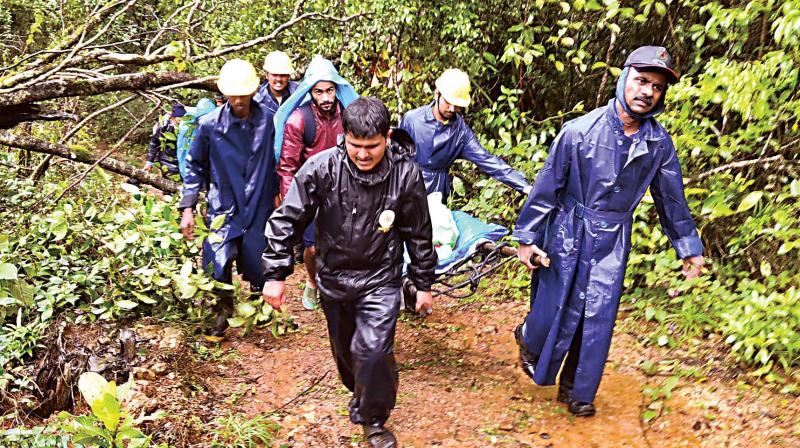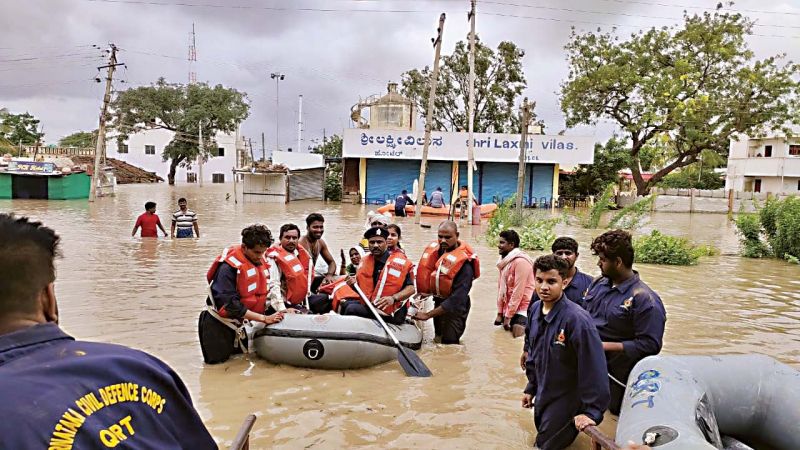Staying afloat & alive in waterworld

They had saved over 2,000 people and nearly 400 cattle, carrying them on their shoulders through five feet of water to safety. Dr. P.R.S Chethan and his five-member rescue team had worked tirelessly, rescuing many people from the jaws of death. Until one fateful night, when death came looking for them. A rescue op in Gangavathi taluk went horribly wrong when 2,70,000 cusecs of water was released from Tungabhadra dam, capsizing their boat and throwing the five rescue workers into the river, known for its deadly currents, sharp rocks, weeds that can defeat the best swimmer and worst of all... crocodiles. These are the rescue workers who risk their own lives to save others. This is their story. Denzil Rithesh reports...
Washed away by 2.7L cusecs of water, Chetan, team live to tell tale
The five-member team, led by P.R.S. Chethan, the Commander of the Civil Defence Quick Response Team, arrived at Gangavathi taluk in Koppal in the early hours of August 12. The team, which had arrived at the transit camp in Davanagere for some much-needed rest, had been working non-stop for four days. It was a frantic call from the DGP that set in a motion a night they would never forget.

The rescue boat was making its way through Gangavathi taluk in the dark, a deviation, technically, of the safety protocol. All of a sudden, 70,000 cusects of water was released from the Tungabhadra dam, sending a powerful jet that capsised their boat. and Dr. Chethan, Nagaraju, Gowtham of Civil Defence Quick Response Team, Sugana Gowda of Fire Brigade and Preetham Singh of NDRF were flung headlong into the deadly currents of the Tungabhadra river, known for having the highest number of rocks and whirlpools. They were thrown in different directions - only Sugana Gowda was rescued after being pulled downstream for about half a kilometer.
The others - Nagaraju, Gowthan and the NDRF’s Preetham Singh, held onto one lifebuoy, which led them to a submerged pongemia tree...

The bravehearts
The floods that washed away entire villages in August this year were captured by the media in waves of stark imagery. The extent of the loss was captured on film and with it, the efforts of those few bravehearts who risked their own lives to help those in danger. Many of these good Samaritans go unnoticed, but some stories do remain, beacons in an episode of great loss and tragedy. The story of Dr P.R.S. Chethan, the commander of the Civil Defence Quick Response Team is one of these.
The team had arrived on August 7 and rescued about 2,250 people, 380 cattle and several other animals during the six-days they spent in the area. Wading through water that was five-feet deep in some places, carrying the injured and the affected on their shoulders they often worked into the night, paying no need to their own safety. Only the night of August 11 was different.
Surviving Tungabhadra
Clinging to the branches of the pongemia tree, Nagaraju and Gowtham found momentary respite as their team-member, Preetham, held on to the lifebuoy. All of a sudden, Gowtham slipped, falling on Nagaraju, who lost his grip on the tree, too. Nagaraju was pushed into the river and dragged for over three-kilometres, towards a 10-foot gorge. Nagaraju fought, trying to swim towards the banks. A small tree was merely 50 metres away. He made a grab for it. He missed. He managed, however, to take hold of a shrub, mere metres away from the gorge. He stayed here for almost four hours. Both Nagaraju and Gowtham were airlifted several hours later.
For Dr Chetan, however, the ordeal had only begun. “No matter how brave or confident we are, how well-trained, in possession of the best equipment - nothing can stand the fury of nature,” says Dr Chetan.
Braving rocks and whirlpools in a crocodile-infested zone can defeat even the most hardy rescuer. “For a moment, everyone I love came to my mind. I thought of the people I have rescued. Would anyone come and save me now?”
These were the thoughts that ran through his mind as he floated for almost 13 hours. His team mates were nowhere in sight, all he could see were hills and trees. Just letting the current carry him was not an option, he had to swim actively to avoid the deadly rocks. After being carried for almost three hours, the river expanded at Anegundi, 12.5 km away from Virupapura Gadde where the boat capsized. Things had just gotten worse.
Anegundi is a haven for crocodiles and the water, choked with weeds. His legs were soon entangled, a situation that can defeat even the best swimmers. Dr Chetan tried to cut them but in vain. He nearly resigned himself to death. “I held on to the weed itself and that worked as a sort of rope support,” he recalls. “I saw a tree about six feet away and to reach it, I grabbed a shrub a few feet away, then leapt onto a rock. Missing my foothold on that rock would have finished me. I took a leap of faith and did it anyway. I made it. I caught two branches, now completely exhausted. I managed to climb a hill at the banks and blew the whistle many times but to no avail.”
Suddenly, a chopper appeared. He removed his life jacket and waved it, but was not seen. “Meanwhile, a few youngsters passing by the foot of the hill on the other side of the river noticed me.”
Back from the dead
Dr Chethan was relieved to see the youngsters but had another surprise in store. They told him that media channels were already proclaiming him dead! “The boys recorded a video of me saying I had escaped from the jaws of death and spread it on social media. I attribute my own survival and that of my team to the little good things that we may have done along the way. It is the blessings of the people we helped that came back to save us.”
Safety
An NDRF team reached the spot and admitted a completely dehydrated Dr Chethan into the ICU of a hospital in Gangavathi. He was given drips and sedated.
The capsized boat was found two days later in the neighbouring district of Bellary’s Kampli Taluk, about 42 kilometer away. It was testament to the strength of the current and the speed at which the water had been flowing.

